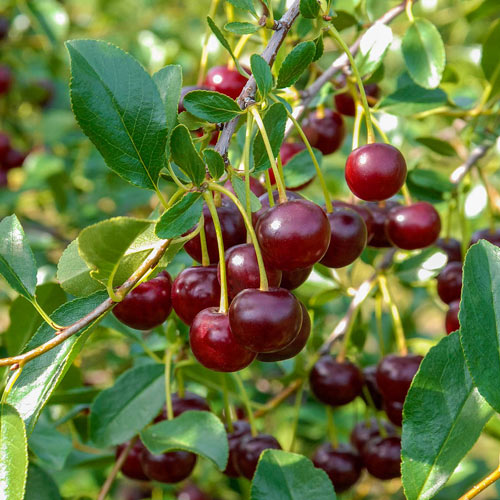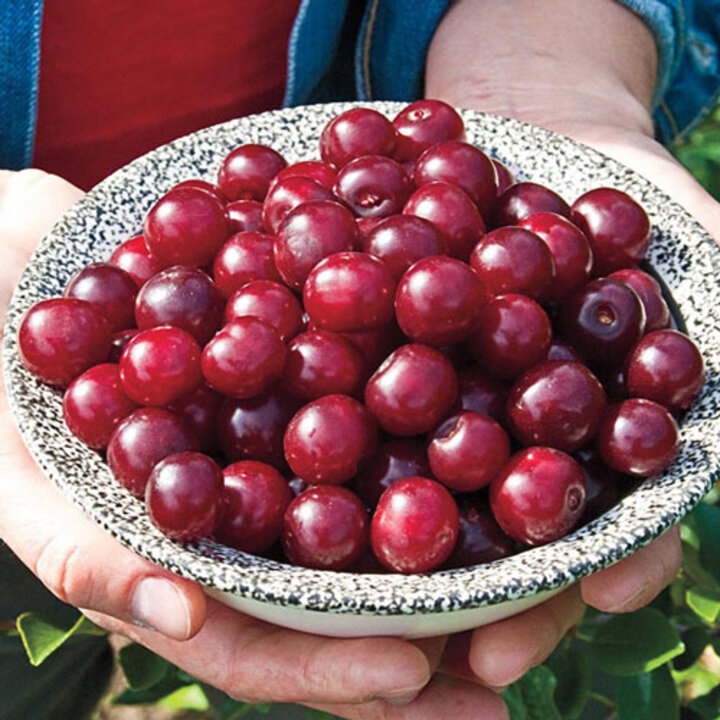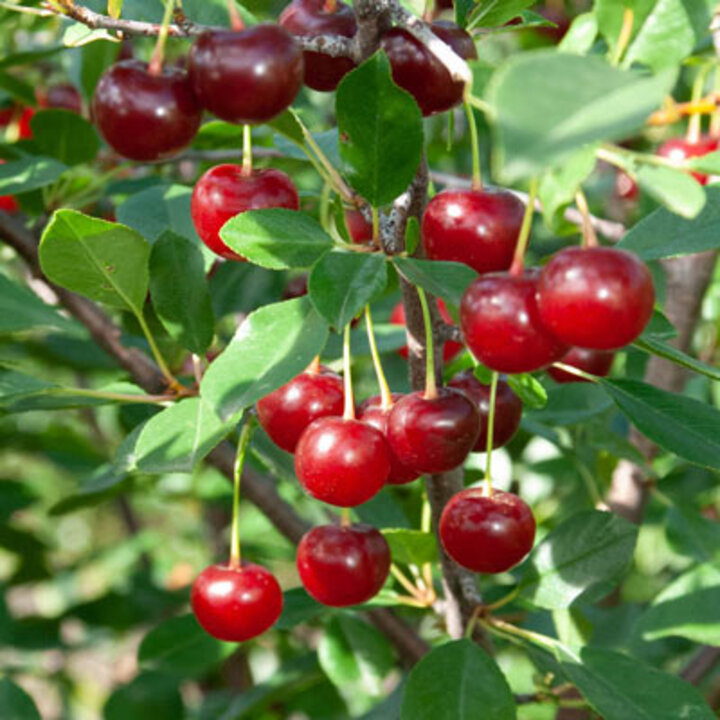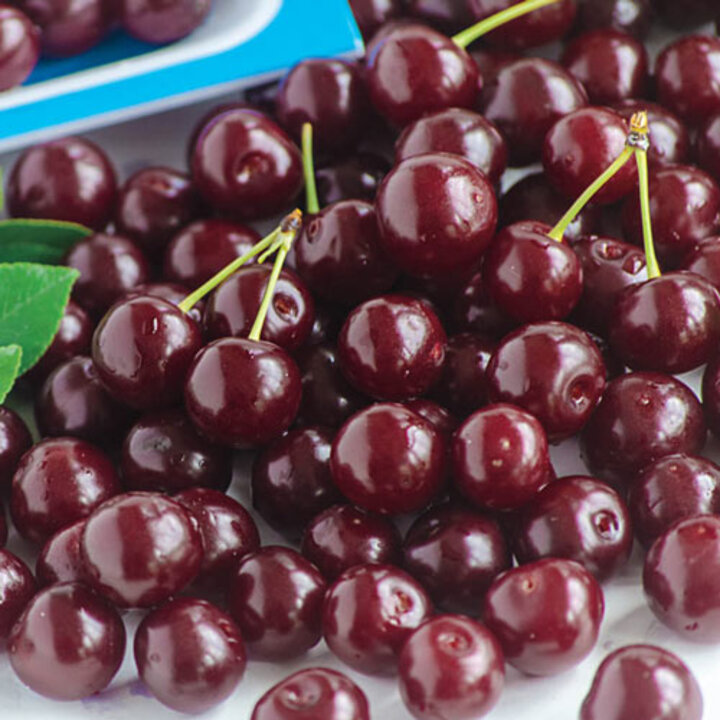Sarah Browning, Nebraska Extension Educator

'Carmine Jewel' cherry. Image from Michigan Bulb Company.
Cherries have been a favored fruit for centuries, eaten by people since before recorded history. Sweet cherries, Prunus avium, are native throughout most of Europe, western Asia and parts of northern Africa. Naturally, they have been used extensively in holiday cooking through the years.
But tart cherries, Prunus cerasus, are the most common and well-adapted cherry grown in Nebraska. Of the tart cherries, 'Montmorency' is the long-time Midwest standard. 'Montmorency' cherry grows into a medium sized tree, 15 to 18 feet in height and width. It has been in cultivation for over 400 years. Other varieties of tart cherry that grow well in Nebraska include 'Meteor' and 'Balaton'. There is also a naturally dwarf variety 'North Star' available, which is extremely hardy and thrives in the harsh Midwest environment. But a new group of cherries, called bush cherries, offer great fruit, even better winter hardiness, and much easier picking due to their short statue.
History of Shrub Cherries
Development of bush cherries began in Canada in the 1940’s and resulted in a variety marketed as the Mongolian cherry. During the 1980’s, breeders at the University of Saskatchewan made crosses between the Mongolian cherry and the naturally dwarf tree form 'North Star'. The result of these crosses were a group of shrub-form tart cherries that are very hardy, with the high fruit quality characteristics of 'North Star' and increased sugar content. The “Romance” cherry series includes the following cultivars – Carmine Jewel, Crimson Passion, Cupid, Juliet, Romeo and Valentine.
Their breeding history makes bush cherries a lesser-known form of tart cherries. They are extremely hardy (Zone 2), suffer from relatively few insect and disease problems and actually have a higher sugar content than tree-types of tart cherries.
Fruit Characteristics

Carmine Jewel- reaches a height of 6 feet, with a similar width. Fruit yields increase as plants mature, starting at 15+ pounds per plant in the fourth year and 20-30+ pounds in the fifth year. It was the first cultivar to be released in 1999 and is available from the nurseries below. (1,2,3,4,6,7)
Crimson Passion– Blooms a few days before Carmine Jewel and has low fruit production compared to Carmine Jewel. Height 10 feet, width 7 feet. Released in 2004 and available from the nurseries below. (1,5,6)

Juliet– Slightly sweeter flavor, moderate fruit production compared to Carmine Jewel. Height 5 to 8 feet. Released in 2004 and available from the nurseries below. (2,3,4,5)

Romeo- Slightly sweeter flavor, moderate fruit production compared to Carmine Jewel. Height 6 to 8 feet. Released in 2004 and available from the nurseries below. (2,3,4,5)
All four cultivars are self-pollinating, meaning the flowers from one bush will pollinate each other, so technically a second pollinating plant is not needed. However, a second pollinating type of bush cherry can increase fruit set. Each plant should be spaced 6 apart in a row.
Unfortunately, Cupid and Valentine are not available to home gardeners.
Fruit Production
Bush forms of cherries begin producing fruit sooner than the tree forms. Fruit production begins at the third year, although there will only be a few fruits that year. Full production is achieved during the fifth year, if the plants have experienced good growing conditions. Carmine Jewel is the best producer with 20 to 30 pounds of fruit per plant once plants are well-established. Depending on the variety, harvest can be as early as late July or as late as September.
But don’t get too rosy a picture of bush cherries. Yes, they offer a high level of winter hardiness and easy harvesting, but they are still susceptible to all the common cherry insect and disease problems. Good site selection, regular care (water, mulch, pruning) and pest control will be required to produce high quality fruits.
Still, even considering maintenance needs, bush cherries can be a highly productive addition to a home orchard or landscape. Their versatility allows them to be planted in a variety of settings – both a formal orchard or a mixed ornamental planting. They can be an integral part of your formal or edible landscape because of their beautiful flowers and fruit. You can plant them in a windbreak enhancing the structure while supplying delicious cherries to you and wildlife. Considering all these benefits, they are well worth the effort too
Talk with your local garden center about ordering these cherry varieties or check with these online garden retailers for spring availability.
- Burnt Ridge Nursery & Orchards
- Gurneys Seed & Nursery Co.
- Nature Hills
- Spring Hill Nurseries
- Veseys
- Honeyberry USA
- Michigan Bulb Co.
My thanks to Vaughn Hammond, former Nebraska Extension Educator, writer of the original version of this article.
Images:
- Feature image - 'Carmine Jewel' cherry. Image from Gurneys Seed Nursery.
- 'Romeo' cherry. Image from Gurneys Seed & Nursery.
- 'Juliet' cherry. Image from Springhill Nursery.
Search Our Archive
Associated Video
Fruit Trees for Nebraska
UNL Extension Landscape Horticulture Specialist Kim Todd shows us some common varieties of fruit trees and bushes that do well in the Midwest.